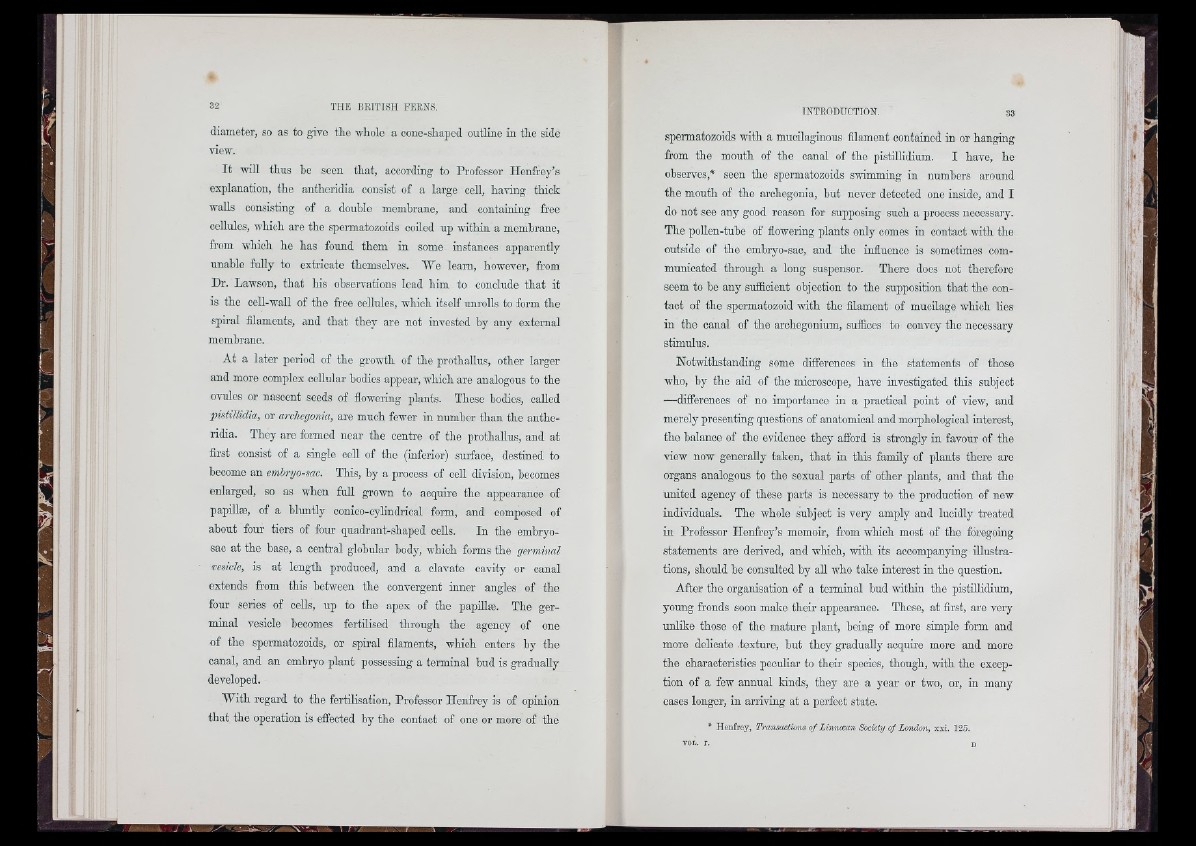
diameter, so as to give tho whole a oone-shapod outline in the side
view.
I t will thus be seen that, according to Professor Ilenfrey’s
explanation, the antheridia consist of a largo coll, having thick
walls consisting of a double membrane, and containing free
cellules, -which are the spermatozoids coded up -within a membrane,
from which he has found them in some instances apparently
unable fully to extricate themselves. We learn, however, from
Dr. Lawson, that his observations lead him to conclude that it
is the cell-wall of the free cellules, which itself unrolls to form the
spiral filaments, and that they aro not invested by any external
membrane.
At a later period of the growth of the prothallus, other larger
and more complex cellular bodies appear, which arc analogous to the
ovules or nascent seeds of flowering plants. These bodies, called
pistillidia, or archegonia, are much fewer in number than the antheridia.
They are fonned near the centre of the prothallus, and at
first consist of a single cell of the (inferior) surface, destined to
become an embryo-sac. This, by a process of cell division, becomes
enlarged, so as when fuU grown to acquire the appearance of
papillffi, of a bluntly conioo-cyhndrical form, and composed of
about four tiers of four quadrant-shapod cells. In the embryo-
sac at the base, a central globular body, which forms the germinal
vesicle, is at length produced, and a clavate cavity or canal
extends from this between the convergent inner angles of the
four series of oeUs, up to the apex of the papillai. The germinal
vesicle becomes fertilised through the agency of one
of the spermatozoids, or spiral filaments, which enters by the
canal, and an embryo plant possessing a terminal hud is gradually
developed.
With regard to the fertilisation. Professor Ilenfrey is of opinion
th a t the operation is effected by the contact of one or more of the
spermatozoids -with a mucilaginous filament contained in or hanging
from the month of the canal of the pistillidium. I have, ho
observes,* seen tho spermatozoids swimming in numbers around
the mouth of tho archegonia, but never detected ono inside, and I
do not see any good reason for supposing such a process necessary.
The pollen-tuho of flowering plants only oomos in contact with the
outside of tho embryo-sac, and tho influence is sometimes communicated
through a long suspcnsor. There does not therefore
seem to bo any sufficient objection to the supposition that tho contact
of the spermatozoid with the filament of mucilage which lies
in tho canal of the arohegonium, suffices to convey the necessary
stimulus.
Notwithstanding some differences in the statements of those
who, by tho aid of the microscope, have investigated this subject
—differences of no importance in a practical point of -vdew, and
merely presenting questions of anatomical and morphological interest,
tho balance of the evidence they afford is strongly in favour of the
-vdow now generally taken, that in this family of plants there aro
organs analogous to the sexual parts of other plants, and that tho
united agency of these parts is necessary to tho production of new
indi-viduals. The whole subject is very amply and lucidly treated
in Professor Ilenfrey’s memoir, from which most of tho foregoing
statements are derived, and which, -with its accompanying illustrations,
should bo consulted by aU who take interest in the question.
After tho organisation of a terminal bud -within tho pistillidium,
young fronds soon make their appearance. Those, at first, aro very
unlike those of the mature plant, being of more simple form and
more delicate -texture, but they gradually acquire more and more
the characteristics peculiar to their species, though, with tho exception
of a few annual kinds, they are a year or two, or, in many
cases longer, in arri-ring at a perfect state.
* Henfroy, Tfansadimis o f L in n im n Society o f Lcriidcm, xxi. 125.
TOL. I. D